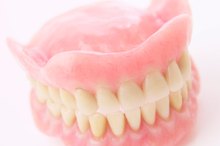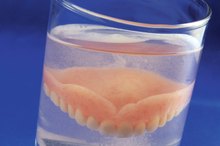What do Partial Dentures Cost?
**Partial dentures might be the answer to restoring your healthy smile.
** Partial dentures, or as dentists affectionately describe them, "flippers," are less expensive than dental implants and an effective way to solve dental problems caused by loss of teeth.
Patients who are not candidates for bridgework often choose partial dentures. In general, costs depend on your dental insurance plan and the type of partial dentures you purchase.
Significance
Partial dentures come in three main types; conventional, semi-precision and precision. Least expensive are conventional partial dentures. These are held in place by clasps, which grip onto natural teeth. The clasps keep the partial denture in place for chewing, swallowing and other normal mouth actions. The next most expensive are semi-precision partial dentures. These use interlocking components, which provide a tighter fit than conventional partials. They do this with an extension that mates with a complementing section on an existing tooth, or crown.
Most expensive are precision partial dentures. These have interlocking components engineered to very high tolerances, providing the best fit of all.
- Partial dentures come in three main types; conventional, semi-precision and precision.
- These use interlocking components, which provide a tighter fit than conventional partials.
Effects
The Difference Between Porcelain Teeth & Acrylic Teeth
Learn More
The cost of your partial dentures will probably range from $500 to $1,000.
The cost depends a lot on whether additional work is involved, such as crowns and extractions. **The location of your dentist is also a factor, as well as the types of materials you and your dentist decide to use.
** Polymer dentures are more expensive than plastic teeth, for example, and different metal types can also have an impact on the cost. Flex partials made of a flexible acrylic cost from $700 to $1,300.
- The cost of your partial dentures will probably range from $500 to $1,000.
- The cost depends a lot on whether additional work is involved, such as crowns and extractions.
Considerations
The primary drawback of conventional partial dentures is that the metal clasps are visible, if only slightly. **This reduces their aesthetic value.
** The advantage of precision and semi-precision partial dentures is that they do not show any metal, and are designed to blend with your remaining teeth. Also, they press more evenly on neighboring teeth than conventional partials, making them more comfortable.
- The primary drawback of conventional partial dentures is that the metal clasps are visible, if only slightly.
Features
What Is the Difference Between Dental Bonding & Veneers?
Learn More
Partial dentures are completely removable. Depending on the type, they are made of metal and pink plastic or acrylic, and have corresponding missing false teeth attached. The devices with underlying metal framework form exactly to your remaining natural teeth. Some partial dentures are made entirely of plastic or a flexible acrylic.
- Partial dentures are completely removable.
- Some partial dentures are made entirely of plastic or a flexible acrylic.
Warning
Even though partial dentures are made of durable materials, they still are subject to wear and can break or wear out. Over time, partial dentures may have to be replaced. The good news is that clasps, and in some cases the plastic, can be repaired, depending on the break.
Partial dentures can last up to five years, with normal wear. Costs of repair are minimal compared to the initial cost of the device.
Partial dentures should be checked every six months or so, as even small problems with teeth can develop into major issues if they go on for too long.
Partial dentures also need to be occasionally relined. Costs of these services may be included in the original agreement or added later. Be sure to ask about the costs of adjustments, repairs and follow-up procedures before signing anything.
- Even though partial dentures are made of durable materials, they still are subject to wear and can break or wear out.
Potential
The impact of missing teeth should not be underestimated.
Left alone, tooth loss can cause your remaining teeth to change position and ultimately damage mouth tissue. It can also cause the face and lips to sag and interfere with speech. Having a partial denture will improve your appearance, make it possible to chew normally and eat a greater variety of foods, protect against loss of your natural teeth and prevent or help TMJ issues (jaw problems).
- The impact of missing teeth should not be underestimated.
- Having a partial denture will improve your appearance, make it possible to chew normally and eat a greater variety of foods, protect against loss of your natural teeth and prevent or help TMJ issues (jaw problems).
Related Articles
References
- The American College of Prosthodontists "Who is a Prosthodontist?"
- The American Dental Association. "Dentures FAQ"
- The National Denturist Association. "What Denturists Do."
Writer Bio
Ingrid Hansen has been published in "Twin Cities Business" magazine, the "Murphy Reporter," "Twin Cities Parent" magazine and the "Southwest Journal" newspaper. She has also written more than 30 non-fiction books for the K-12 library and education market, and has been a subject matter expert and a course designer for online college curriculum. She teaches English Composition at a local college, and holds a Master of Fine Arts in creative writing from Hamline University.









